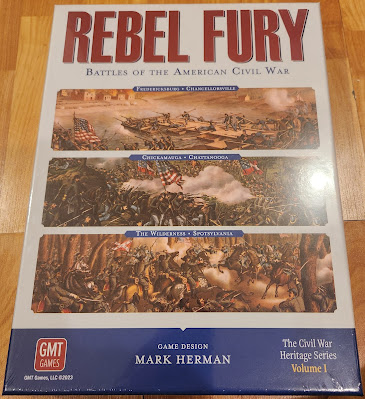Coming home yesterday, I was excited to see yet another package from GMT, with this month's releases that I had ordered: France '40 2nd Edition (with mounted map), and Rebel Fury. Both of these appeal to me for different reasons, but we'll talk about the France game another time.
Rebel Fury, designed by Mark Herman, is a game covering six battles of the American Civil War: Chickamauga, Chattanooga, Chancellorsville, Fredericksburg, Spotsylvania, and The Wilderness. Despite my love of history, I admit my knowledge of the ACW is not particularly great. Having a game that covers the battles gives me a way to learn about them in an enjoyable way. This game in particular is interesting because the system is based on the well-regarded Gettysburg game from c3i issue 32, which is fairly low complexity, and also seems pretty light on counter density (the battles here look to have 50ish counters on the board at a time? Quite light).
The game box looks sharp, and has that traditional GMT look that I haven't seen for a few releases. Of note is that this is Volume 1 of a series, and Mark Herman has already been showing some pictures of progress on the next volume on Twitter/X.
Here we have the back of the box. It has a listed complexity of three, which fits with what I have heard about the Gettysburg game. The Solitaire Suitability of five indicates that there isn't a solo system included, but I should mention there is a solitaire scenario (Fredericksburg), and my brief read of the rules does not show anything that would prohibit good solitaire games.
First item when you open the box is the dice, two standard ten-sided dice... and this unique six-sided dice.
That's different. The rules mention it only briefly, in applying in some cases to the Defender in combat, with its interpretation shown on the Attack Results Table in the Player Aid Charts (shown later on).
Next up is the Playbook, with rules on how to set up and play the scenarios. One thing I found a little disappointing was the lack of historical blurb before each scenario- these brief descriptions of the events and context of the battle are items I find extremely enjoyable in wargames (for instance, I love reading these in the Great Battles of History and Men of Iron games). Sure, I can just, I don't know, read about the battle in Wikipedia. But I really wish there was something included. Anyway, very small complaint.
And here is the rulebook, full color, and very nice. You can read it here.
Next up, two identical Player Aid Cards, with some rules summaries and charts on the front, and terrain rules on the back. Nice quality, and not too crowded.
A game tracking card, with unique turn tracks for each scenario. I believe Artillery Points are also tracked here, although it is not listed on this card.
Here we have an off-map movement display for the Fredericksburg and Chancellorsville scenarios. For the former, it operates as a holding box for reinforcements, essentially. For the latter, it provides options for reinforcement arrival locations (the letters in hexagons correspond to locations on the play maps). Rules for this are included in the main rulebook, with a mention that only Union troops use them in Volume I, so it seems likely we will see this method used in future volumes. A really cool way to handle this.
Game comes with two countersheets, using blue for the Union troops, and grey for the Confederate troops. The reverse side of these counters show the unit in battle formation (versus the maneuver formation shown above). Each game uses its own unique set of unit counters, and you can tell which scenario the counter is for by the white circled letter on the top left of the counter. HQs likewise have a maneuver and battle side to their counters. Given the counter inventory (note the three time counters...), you apparently are able to play three scenarios simultaneously, one on each of the maps, assuming you have Player Aid Cards and game tracking cards for everyone. That's a cool concept, certainly, and given that these units are not shared between scenarios, reinforces that indeed, these games will have low counter densities.
Each map has two scenarios that can be played on it, listed in one of the bottom corners. These maps are beautiful- if I may, let me show you a close-up of one of them:
There are tons of detail, and they look very interesting to play on. The map art was done by Charles Kibler, and I have to say, I quite like it.
And there you have it. A nice product, with a good variety of scenarios using a well-regarded system. Another great game from GMT, and one that I *think* I can get on the table before summer. I'll let you know when I do :).
















No comments:
Post a Comment